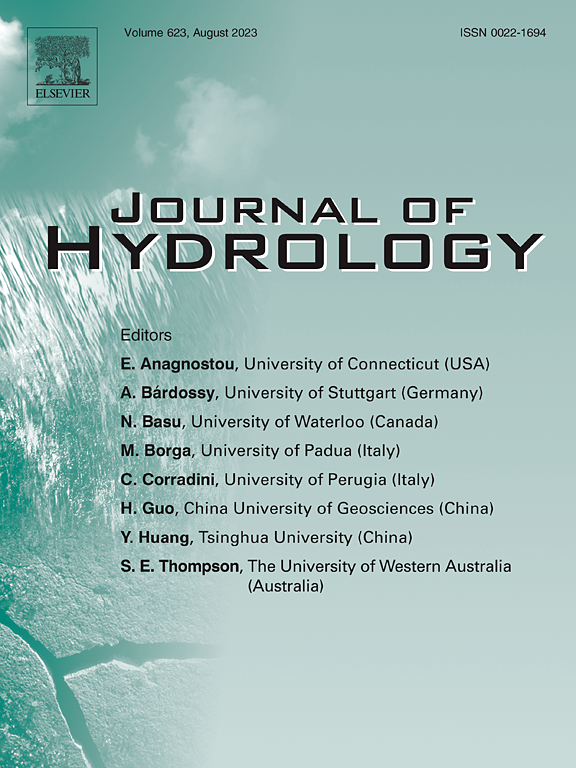种间相互作用增强土壤抗侵蚀能力:模拟降雨条件下混交草种的协同效应
IF 5.9
1区 地球科学
Q1 ENGINEERING, CIVIL
引用次数: 0
摘要
在实际应用中,草本植物混播是一种潜在的生态恢复策略。然而,混交草对降雨土壤侵蚀的影响很少被评价。通过模拟降雨试验,研究了不同降雨强度下黑麦草和梭子草单播和混播对坡面流和土壤流失的影响。结果表明,混播显著提高了地上部性状,叶面积指数比单作冬青提高67.86%,比单作冬青提高11.46%。地下性状的改善更为明显,根系生物量分别比长草增加了80.13%和59.66%,根长密度分别比长草增加了68.14%和29.42%,根质量密度分别比长草增加了79.81%和59.83%。在所有降雨强度下,混合播种均表现出较好的减少土壤脱落的效果,土壤脱落的减少幅度在57.86% ~ 92.91%之间。在强降雨条件下,混合播种下种间相互作用的贡献尤为显著,对减少径流和土壤分离的相对贡献分别高达29.39%和21.90%。植被的存在显著改变了水动力参数以减轻侵蚀。混合播种使水流功率降低了19.66% ~ 71.35%,使达西-韦斯巴赫摩擦系数提高了1.33 ~ 3.29倍。土壤分离速率与径流剪应力和水流功率呈线性关系。与单一栽培相比,混合播种提高了土壤抗侵蚀能力,土壤可蚀性降低30.57 ~ 44.06%,临界水流功率降低7.59 ~ 21.18%,临界剪切应力增加5.68 ~ 9.41%。土壤脱落率与地上、地下性状均呈负指数关系,混合播种增加了地上、地下性状,土壤脱落率降低。深入了解不同降雨强度下混合播种的侵蚀控制机制,为坡面植被配置提供科学指导。本文章由计算机程序翻译,如有差异,请以英文原文为准。
Interspecific interactions enhance soil resistance to erosion: Synergistic effects of mixed grass species under simulated rainfall
Mixed seeding of herbaceous plants was frequently employed as a potential ecological restoration strategy in practical applications. However, the effects of mixed grass species to rainfall-induced soil erosion has rarely been evaluated. This study investigated the effects of single and mixed seeding of Lolium perenne and Cynodon dactylon on overland flow and soil loss under varying rainfall intensities through simulated rainfall experiments. The results demonstrated that mixed seeding significantly enhanced aboveground traits, with leaf area index increasing by 67.86 % compared to C. dactylon monocultures and 11.46 % compared to L. perenne monocultures. Belowground traits showed even greater improvements, with root biomass increasing by 80.13 % (vs. C. dactylon) and 59.66 % (vs. L. perenne), root length density by 68.14 % and 29.42 %, and root mass density by 79.81 % and 59.83 %, respectively. Mixed seeding demonstrated superior soil detachment reduction under all rainfall intensities, with soil detachment reductions ranging from 57.86 % to 92.91 %. The contribution of interspecific interactions under mixed seeding is particularly pronounced during intense rainfall, with relative contributions to runoff and soil detachment reduction reaching up to 29.39 % and 21.90 %, respectively. The presence of vegetation significantly altered hydrodynamic parameters to mitigate erosion. Mixed seeding decreased stream power by 19.66 % to 71.35 %, and enhanced the Darcy–Weisbach friction coefficient by a factor of 1.33 ∼ 3.29 relative to single-seeding. Soil detachment rates exhibited a linear relationship with runoff shear stress and stream power. Mixed seeding enhanced soil resistance to erosion by reducing soil erodibility by 30.57 ∼ 44.06 % and critical stream power by 7.59 ∼ 21.18 %, while increasing critical shear stress by 5.68 ∼ 9.41 % compared to monocultures. Furthermore, soil detachment rates exhibited a negative exponential relationship with both aboveground and belowground traits, with the increased traits induced by mixed seeding leading to reduced soil detachment rates. This study provides an in-depth understanding of the erosion control mechanisms of mixed seeding under different rainfall intensities, offering scientific guidance for vegetation configuration on slopes.
求助全文
通过发布文献求助,成功后即可免费获取论文全文。
去求助
来源期刊

Journal of Hydrology
地学-地球科学综合
CiteScore
11.00
自引率
12.50%
发文量
1309
审稿时长
7.5 months
期刊介绍:
The Journal of Hydrology publishes original research papers and comprehensive reviews in all the subfields of the hydrological sciences including water based management and policy issues that impact on economics and society. These comprise, but are not limited to the physical, chemical, biogeochemical, stochastic and systems aspects of surface and groundwater hydrology, hydrometeorology and hydrogeology. Relevant topics incorporating the insights and methodologies of disciplines such as climatology, water resource systems, hydraulics, agrohydrology, geomorphology, soil science, instrumentation and remote sensing, civil and environmental engineering are included. Social science perspectives on hydrological problems such as resource and ecological economics, environmental sociology, psychology and behavioural science, management and policy analysis are also invited. Multi-and interdisciplinary analyses of hydrological problems are within scope. The science published in the Journal of Hydrology is relevant to catchment scales rather than exclusively to a local scale or site.
 求助内容:
求助内容: 应助结果提醒方式:
应助结果提醒方式:


